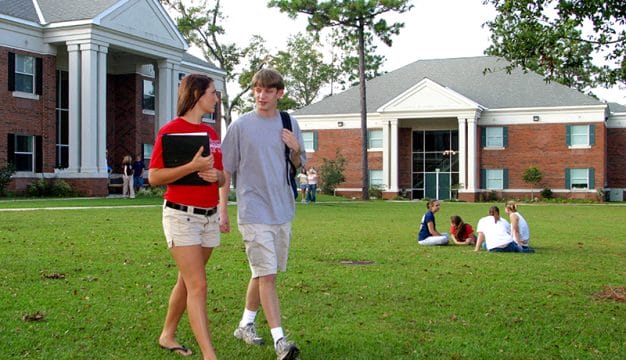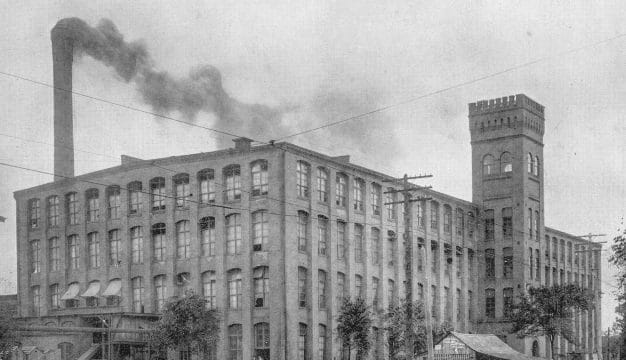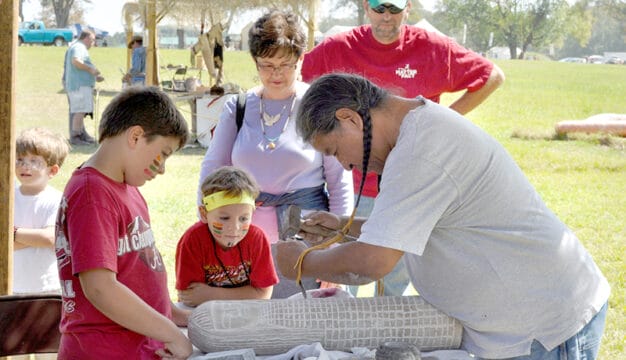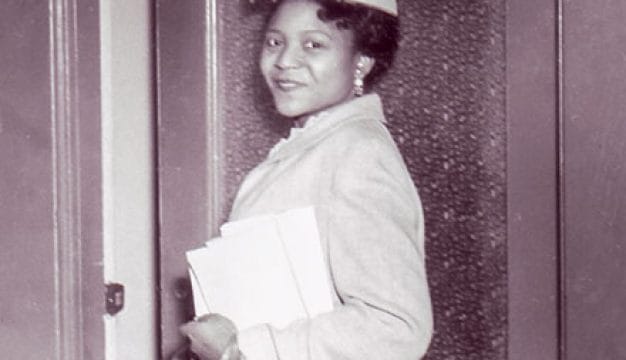University of Montevallo
The University of Montevallo, located in Montevallo, Shelby County, was founded on October 12, 1896, as the Alabama Girls’ Industrial School (AGIS). Since that time, it has grown into a premier public liberal-arts university known for the academic achievements of its students and faculty. Its approximately 3,000 students are served by four colleges and can choose among 30 academic programs.
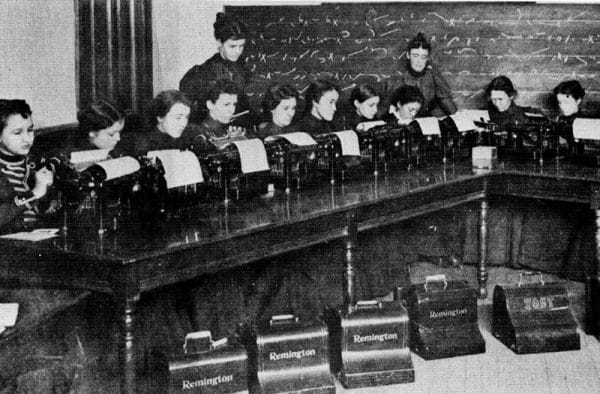 Typing Class, Alabama Girls’ Industrial School
AGIS, an industrial high school for girls, was established through the joint efforts of Julia Tutwiler, reformer and advocate for educational opportunities for women, and state senator Sol Bloch of Camden, who introduced the legislation that established the school. Senate Bill No. 5, signed into law by Gov. William C. Oates on February 18, 1893, appointed a board of trustees and called upon them to establish a school to educate white women in subjects ranging from telegraphy and carpentry to home nursing and kindergarten instruction. On its opening day in 1896, AGIS welcomed its first class of 150 young women from across the state.
Typing Class, Alabama Girls’ Industrial School
AGIS, an industrial high school for girls, was established through the joint efforts of Julia Tutwiler, reformer and advocate for educational opportunities for women, and state senator Sol Bloch of Camden, who introduced the legislation that established the school. Senate Bill No. 5, signed into law by Gov. William C. Oates on February 18, 1893, appointed a board of trustees and called upon them to establish a school to educate white women in subjects ranging from telegraphy and carpentry to home nursing and kindergarten instruction. On its opening day in 1896, AGIS welcomed its first class of 150 young women from across the state.
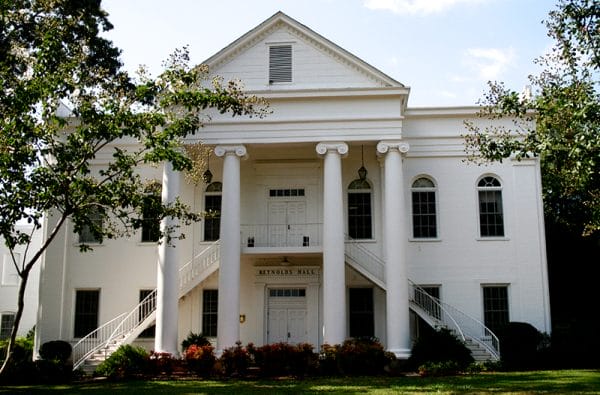 Reynolds Hall
Capt. Henry Clay Reynolds, a local merchant who had chaired the committee that worked to bring the school to Montevallo, served as the school’s first president. A resident of Montevallo, he had been one of the leading advocates for locating the school in the unincorporated village. Progressive reformer and educator Julia Tutwiler was offered the initial presidency, but she declined, saying that the $15,000 appropriated by the state to start the school was not sufficient. Reynolds was joined by eight faculty members in teaching courses in mathematics and bookkeeping, English and history, pedagogy, instrumental and vocal music, art, stenography and typing, sewing, dressmaking, and millinery.
Reynolds Hall
Capt. Henry Clay Reynolds, a local merchant who had chaired the committee that worked to bring the school to Montevallo, served as the school’s first president. A resident of Montevallo, he had been one of the leading advocates for locating the school in the unincorporated village. Progressive reformer and educator Julia Tutwiler was offered the initial presidency, but she declined, saying that the $15,000 appropriated by the state to start the school was not sufficient. Reynolds was joined by eight faculty members in teaching courses in mathematics and bookkeeping, English and history, pedagogy, instrumental and vocal music, art, stenography and typing, sewing, dressmaking, and millinery.
The first building to be constructed on the campus was the Main Dormitory, the west wing of which was ready to house about 100 students by the time school opened in 1897. Classes were held in Reynolds Hall, which had been constructed in 1851 for use by the Montevallo Male Institute (later named the Montevallo Male and Female Collegiate Institute).
Francis Marion Peterson, a professor of ancient languages and a Methodist minister, succeeded Reynolds as president of AGIS in 1899. During his presidency, Main Dormitory was completed with the construction of the East Wing, and wings were added to Reynolds Hall to increase the number of classrooms to 27. Courses in physical culture (physical education) and physiology were added to the curriculum, and, with plans to add instruction in horticulture and dairy farming, the school purchased a nearby farm.
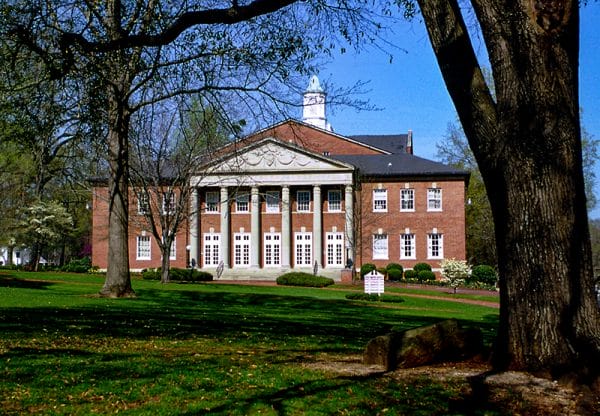 University of Montevallo
In 1907, Thomas Waverly Palmer, professor of mathematics and dean of the University of Alabama, became the third president of the school, serving almost 19 years. Palmer guided the school through many transitions. He established a dairy to ensure an adequate and reliable supply of milk for the kitchens and to provide students with a laboratory for learning about dairy farming. Palmer also oversaw the expansion of the campus and its facilities. The school purchased several adjacent properties, including the home and family cemetery of one of Montevallo’s founding residents, Edmund King. This new land allowed for the construction of Bloch Hall, the first building on campus dedicated to academic work, as well as the campus’s central feature, the Tower. Constructed in 1910-11, this landmark served as the campus water storage facility until 1962.
University of Montevallo
In 1907, Thomas Waverly Palmer, professor of mathematics and dean of the University of Alabama, became the third president of the school, serving almost 19 years. Palmer guided the school through many transitions. He established a dairy to ensure an adequate and reliable supply of milk for the kitchens and to provide students with a laboratory for learning about dairy farming. Palmer also oversaw the expansion of the campus and its facilities. The school purchased several adjacent properties, including the home and family cemetery of one of Montevallo’s founding residents, Edmund King. This new land allowed for the construction of Bloch Hall, the first building on campus dedicated to academic work, as well as the campus’s central feature, the Tower. Constructed in 1910-11, this landmark served as the campus water storage facility until 1962.
In 1911, Alabama Girls’ Industrial School became the Girls’ Technical Institute, and the phrase “and College for Women” was added in 1919, when the school became a college offering courses in the liberal arts. In 1923, the school became Alabama College, State College for Women, a degree-granting institution that was accredited by the Southern Association of Colleges and Secondary Schools in 1925. As Alabama College developed, students became more interested in traditional college courses, as well as in preparation for careers in education and home economics. For the 1907-08 term, the college introduced home economics into the curriculum, and Alabama College awarded its first degree, a Bachelor of Science in vocational home economics, in 1922.
For many years, Alabama College was the only institution of higher education offering coursework in vocational home economics, retail home economics, and institutional management. Graduates of Alabama College were instrumental in establishing home economics programs at the state’s flagship institutions, Auburn University and the University of Alabama. Alabama College also pioneered teacher education in art, music, physical education, and commercial subjects, as well as in home economics. When the town of Montevallo built a public school in what is now Jeter Hall, education students used it as a training school. The college also was the first institution in the state to offer programs in social work and speech pathology. At the time that the social work department was founded in 1925, only the University of North Carolina offered a degree in the field. In 1952, Alabama College opened the state’s first speech clinic, which continues today as the George C. Wallace Speech and Hearing Center
In the years following World War II, enrollment at Alabama College declined. By the 1954-55 academic year, the school had only 487 students. Faculty, students, and administration decided that the best way for the institution to survive was for it to become a coeducational liberal-arts college. After legislative approval, two men enrolled in the spring of 1956, and by the following fall, 35 men were attending the college.
Montevallo did not experience the turbulence seen on other college campuses during the 1960s. In 1965, the board of trustees authorized Pres. Delos P. Culp to sign the Certificates of Assurance of Compliance with the Civil Rights Act of 1964. In the fall of 1968, three African American women, Carolyn Buprop, Ruby Kennbrew, and Dorothy (Lilly) Turner, enrolled in the university.
 Alabama College to University of Montevallo
On September 1, 1969, in recognition of the college’s growth in enrollment and the expansion of its graduate and undergraduate programs, Alabama College became the University of Montevallo. At that time, the university curriculum was divided among three distinct colleges: Business, Education, and Liberal Arts. In 1973, the College of Fine Arts was created. The university’s four colleges today are the College of Arts and Sciences (the largest college), the Michael E. Stephens College of Business, the College of Education, and the College of Fine Arts. The University of Montevallo also offers graduate and post-secondary degrees. Enrollment currently stands at just under 3,000 students, with a total faculty of 208. The student to faculty ratio is 16 to 1. The university belongs to the prestigious Council of Public Liberal Arts Colleges and is one of only 25 public liberal-arts institutions in the United States. The university is accredited by the Southern Association of Colleges and Schools, and its academic programs are accredited by 11 different professional accrediting agencies.
Alabama College to University of Montevallo
On September 1, 1969, in recognition of the college’s growth in enrollment and the expansion of its graduate and undergraduate programs, Alabama College became the University of Montevallo. At that time, the university curriculum was divided among three distinct colleges: Business, Education, and Liberal Arts. In 1973, the College of Fine Arts was created. The university’s four colleges today are the College of Arts and Sciences (the largest college), the Michael E. Stephens College of Business, the College of Education, and the College of Fine Arts. The University of Montevallo also offers graduate and post-secondary degrees. Enrollment currently stands at just under 3,000 students, with a total faculty of 208. The student to faculty ratio is 16 to 1. The university belongs to the prestigious Council of Public Liberal Arts Colleges and is one of only 25 public liberal-arts institutions in the United States. The university is accredited by the Southern Association of Colleges and Schools, and its academic programs are accredited by 11 different professional accrediting agencies.
The university is a member of NCAA Division II and fields teams in men’s baseball, basketball, golf, and soccer and women’s basketball, cross country, golf, tennis, and volleyball. The school colors are purple and gold, and the teams are known as the Falcons and the Lady Falcons. The University of Montevallo is a member of the Gulf South Conference.
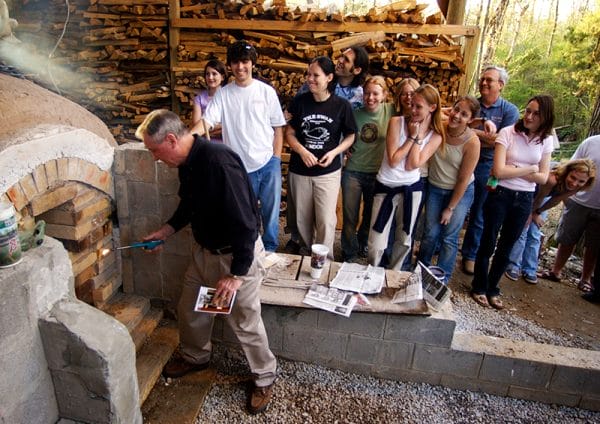 Art Students at the University of Montevallo
One of the University of Montevallo’s most treasured traditions, College Night, began in 1919. It has since grown into a three-day event held in mid-February, culminating in the performance of original one-act musicals written and staged by two teams, the Purples and the Golds. The Library of Congress’s American Folklife Center included College Night among the 1,300 Local Legacies registered by Congress as part of the Local Legacies project in 2000. Students at the University of Montevallo may choose to join one of five fraternities or 10 sororities, and they have the opportunity to participate in a wide variety of academic, honorary, and special-interest clubs and organizations. The student newspaper, The Alabamian, is published irregularly. Other student publications are the literary magazine The Tower and The Montage yearbook, both of which are published annually.
Art Students at the University of Montevallo
One of the University of Montevallo’s most treasured traditions, College Night, began in 1919. It has since grown into a three-day event held in mid-February, culminating in the performance of original one-act musicals written and staged by two teams, the Purples and the Golds. The Library of Congress’s American Folklife Center included College Night among the 1,300 Local Legacies registered by Congress as part of the Local Legacies project in 2000. Students at the University of Montevallo may choose to join one of five fraternities or 10 sororities, and they have the opportunity to participate in a wide variety of academic, honorary, and special-interest clubs and organizations. The student newspaper, The Alabamian, is published irregularly. Other student publications are the literary magazine The Tower and The Montage yearbook, both of which are published annually.
Located in the geographic center of Alabama, the university’s campus features white-columned brick buildings, redbrick streets, stately trees, and expansive lawns. The grounds were designed by the Olmsted Brothers, who also created New York’s Central Park and the Biltmore House grounds in Asheville, North Carolina. The central part of the Montevallo campus is designated as a National Historic District, and 28 campus structures or sites are listed on the National Register of Historic Places.
Additional Resources
Griffith, Lucille. Alabama College, 1896-1969. Montevallo, Ala.: University of Montevallo, 1969.
Nutting, Alissa. “Montevallo: Mound in a Valley.” Alabama Heritage 84 (Spring 2007): 20-29.
Tipton, Mary Frances. Years Rich and Fruitful: University of Montevallo, 1896-1996. Montevallo, Ala.: University of Montevallo, 1996.
